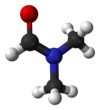Dimethyl formamide
 |
|||
|
|
|||
| Names | |||
|---|---|---|---|
|
Preferred IUPAC name
N,N-Dimethylformamide
|
|||
| Other names
Dimethylformamide
N,N-Dimethylmethanamide DMF |
|||
| Identifiers | |||
|
3D model (Jmol)
|
|||
| 3DMet | B00545 | ||
| 605365 | |||
| ChEBI | |||
| ChemSpider | |||
| DrugBank | |||
| ECHA InfoCard | 100.000.617 | ||
| EC Number | 200-679-5 | ||
| KEGG | |||
| MeSH | Dimethylformamide | ||
|
PubChem CID
|
|||
| RTECS number | LQ2100000 | ||
| UNII | |||
| UN number | 2265 | ||
|
|||
|
|||
| Properties | |||
| C3H7NO | |||
| Molar mass | 73.10 g·mol−1 | ||
| Appearance | Colourless liquid | ||
| Odor | fishy, ammoniacal | ||
| Density | 0.948 g mL−1 | ||
| Melting point | −60.5 °C; −76.8 °F; 212.7 K | ||
| Boiling point | 152 to 154 °C; 305 to 309 °F; 425 to 427 K | ||
| Miscible | |||
| log P | −0.829 | ||
| Vapor pressure | 516 Pa | ||
| UV-vis (λmax) | 270 nm | ||
| Absorbance | 1.00 | ||
|
Refractive index (nD)
|
1.4305 (at 20 °C) | ||
| Viscosity | 0.92 mPa s (at 20 °C) | ||
| Structure | |||
| 3.86 D | |||
| Thermochemistry | |||
| 146.05 J K−1 mol−1 | |||
|
Std enthalpy of
formation (ΔfH |
−240.6–−238.2 kJ mol−1 | ||
|
Std enthalpy of
combustion (ΔcH |
−1.9428–−1.9404 MJ mol−1 | ||
| Hazards | |||
| Safety data sheet | See: data page | ||
| GHS pictograms |
  
|
||
| GHS signal word | DANGER | ||
| H226, H312, H319, H332, H360 | |||
| P280, P305+351+338, P308+313 | |||
|
EU classification (DSD)
|
|||
| R-phrases | R61, R20/21, R36 | ||
| S-phrases | S53, S45 | ||
| NFPA 704 | |||
| Flash point | 58 °C (136 °F; 331 K) | ||
| 445 °C (833 °F; 718 K) | |||
| Explosive limits | 2.2–15.2% | ||
| 30 mg m−3 (TWA) | |||
| Lethal dose or concentration (LD, LC): | |||
|
LD50 (median dose)
|
|
||
|
LC50 (median concentration)
|
3092 ppm (mouse, 2 hr) | ||
|
LCLo (lowest published)
|
5000 ppm (rat, 6 hr) | ||
| US health exposure limits (NIOSH): | |||
|
PEL (Permissible)
|
TWA 10 ppm (30 mg/m3) [skin] | ||
|
REL (Recommended)
|
TWA 10 ppm (30 mg/m3) [skin] | ||
|
IDLH (Immediate danger)
|
500 ppm | ||
| Related compounds | |||
|
Related alkanamides
|
|||
|
Related compounds
|
|||
| Supplementary data page | |||
|
Refractive index (n), Dielectric constant (εr), etc. |
|||
|
Thermodynamic
data |
Phase behaviour solid–liquid–gas |
||
| UV, IR, NMR, MS | |||
|
Except where otherwise noted, data are given for materials in their standard state (at 25 °C [77 °F], 100 kPa).
|
|||
|
|
|||
| Infobox references | |||
Dimethylformamide is an organic compound with the formula (CH3)2NC(O)H. Commonly abbreviated as DMF (although this acronym is sometimes used for dimethylfuran, or dimethyl fumarate), this colourless liquid is miscible with water and the majority of organic liquids. DMF is a common solvent for chemical reactions. Dimethylformamide is odorless whereas technical grade or degraded samples often have a fishy smell due to impurity of dimethylamine. As its name indicates, it is a derivative of formamide, the amide of formic acid. DMF is a polar (hydrophilic) aprotic solvent with a high boiling point. It facilitates reactions that follow polar mechanisms, such as SN2 reactions.
As for most amides, the spectroscopic evidence indicates partial double bond character for the C-N and C-O bonds. Thus, the infrared spectrum shows a C=O stretching frequency at only 1675 cm−1, whereas a ketone would absorb near 1700 cm−1. The methyl groups are inequivalent on the NMR time scale, giving rise to two singlets of 3 protons each at δ 2.97 and 2.88 in the proton NMR spectrum in chloroform-d.
DMF is miscible with water. The vapour pressure at 20 °C is 3.5hPa. A Henry's law constant of 7.47×10−5 hPa·m3/mol can be deduced from an experimentally determined equilibrium constant at 25 °C. The partition coefficient logPOW is measured to −0.85. Since the density of DMF (0.95 g/cm3 at 20 °C) is very similar to that of water, significant flotation or stratification in surface waters in case of accidental losses is not expected.
...
Wikipedia



